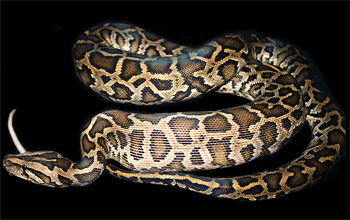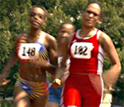News Release 05-029
A “Hearty” Eater
Big Meals Condition a Snake’s Heart

The tail and a large bulge are the only signs of a rat after being ingested by this python.
March 2, 2005
This material is available primarily for archival purposes. Telephone numbers or other contact information may be out of date; please see current contact information at media contacts.
A Burmese python is strong, but is it a model for human exercise? According an article published in the March 3 issue of the journal Nature, the snake’s eating habits make it a prime model of cardiovascular fitness. The heart has the amazing ability to adapt to altered physiological requirements, and, according to the authors, this cold-blooded snake may provide insights into how remodeling of the heart occurs in adapting to prolonged exercise and in response to some diseases.
The python does not eat frequently; it’s more of a binge eater. James Hicks at the University of California, Irvine, together with his colleagues, discovered the snake's tell-tale heart undergoes drastic physiological changes after the reptile consumes a large meal. Hicks observed that the snake’s oxygen consumption increased seven-fold within 24 to 48 hours after eating. This heightened metabolic state lasted for up to seven days and was accompanied by a rapid remodeling of the ventricle--the lower portion of the blood-pumping organ. In experiments, the python’s ventricle increased in mass by 40 percent within 48 hours.
Unlike a human heart, which has two ventricles or pumping chambers, a reptile heart has only one.
“In mammals, including humans, a 10-30 percent increase in ventricular mass can occur following several weeks to months of intense aerobic training,” said Hicks.
In the snake, the rapid ventricular growth coincided with an increased production of the muscle protein, myosin. Myosin is involved in muscle contraction, and hence, plays a key role in pumping blood.
Hicks and his colleagues propose that these animals could be an informative model for investigating fundamental mechanisms leading to cardiac remodeling and ventricular growth in other animals, including humans.
Hicks’ research is supported by the Integrative Organismal Biology program at the National Science Foundation.
-NSF-
-
In response to weeks of intense training, the ventricle of the human heart increases in size.
Credit and Larger Version
Media Contacts
Randy Vines, NSF, (703) 292-8070, email: rvines@nsf.gov
Program Contacts
Ione Hunt von Herbing, NSF - Biology Directorate, (703) 292-8413, email: ihuntvon@nsf.gov
Principal Investigators
James Hicks, University of California Irvine, (949) 824-6386, email: jhicks@uci.edu
The U.S. National Science Foundation propels the nation forward by advancing fundamental research in all fields of science and engineering. NSF supports research and people by providing facilities, instruments and funding to support their ingenuity and sustain the U.S. as a global leader in research and innovation. With a fiscal year 2023 budget of $9.5 billion, NSF funds reach all 50 states through grants to nearly 2,000 colleges, universities and institutions. Each year, NSF receives more than 40,000 competitive proposals and makes about 11,000 new awards. Those awards include support for cooperative research with industry, Arctic and Antarctic research and operations, and U.S. participation in international scientific efforts.
Connect with us online
NSF website: nsf.gov
NSF News: nsf.gov/news
For News Media: nsf.gov/news/newsroom
Statistics: nsf.gov/statistics/
Awards database: nsf.gov/awardsearch/
Follow us on social
Twitter: twitter.com/NSF
Facebook: facebook.com/US.NSF
Instagram: instagram.com/nsfgov

